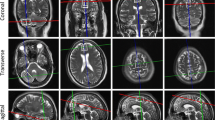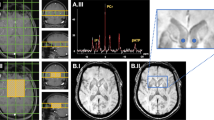Abstract
Animal studies have suggested an increased striatal glutamate activity in Parkinson's disease models, although this has not been substantiated in magnetic resonance spectroscopy studies in patients. Our initial aim was to assess glutamate and glutamine levels in the striatum of patients with idiopathic Parkinson's disease, using multivoxel proton magnetic resonance spectroscopy techniques. Since data were collected from other areas of the brain without a priori selection, information on the cortex was also obtained. Twelve healthy volunteers, seven dyskinetic and five non-dyskinetic patients were studied. Peak area ratios of choline-containing compounds (Cho), glutamine and glutamate (Glx) and N-acetyl moieties including N-acetylaspartate (NAx), relative to creatine (Cr) were calculated. Spectra were analysed from the corpus striatum, the occipital cortex and the temporo-parietal cortex. The median Glx/Cr ratio was unaltered in the striatal spectra of Parkinson's disease patients compared to healthy controls. However, the more severely affected patients had significantly reduced NAx/Cr ratios in spectra localised to the temporo-parietal cortex, compared to healthy controls. Furthermore, the entire patient population had significantly reduced Cho/Cr ratios in spectra from the temporo-parietal cortex, compared to the reference population. We found no evidence of increased striatal glutamate in either dyskinetic or non-dyskinetic Parkinson's disease. However, the low NAx/Cr and Cho/Cr ratios in the temporo-parietal cortex may indicate the presence of subclinical cortical dysfunction.
Similar content being viewed by others
REFERENCES
Albin, R.L., Young, A.B., and Penney, J.B. (1989). The functional anatomy of basal ganglia disorders. TINS 12:366-375.
Albin, R.L., Makowiec, R.L., Hollingsworth, Z.R., Dure, I.V.L.S., Penney, J.B., and Young, A.B. (1992). Excitatory amino acid binding sites in the basal ganglia of the rat: a quantitative autoradiographic study. Neuroscience 46:35-48.
Bedard, P.J., Gomex Mancilla, B., Blanchette, P., Gagnon, C., and Di Paolo, T. (1992). Levadopa-induced dyskinesia: facts and fancy. What does the MPTP monkey model tell us? Can. J. Neurol. Sci. 19:134-137.
Bedard, P.J., Blanchet, P.J., Calon, F., and DiPaolo, T. (1994). The paradox of dyskinesia and wearing-off. A hypothesis based on observations in the NPTP monkey model of parkinsonism. Mov. Disord. 9(suppl 1):153.
Blanchet, P.J., Verhagen Metman, L., Mouradian, M.M., and Chase, T.N. (1996). Acute pharmacologic blockade of dyskinesias in Parkinson's disease. Mov. Disord. 11:580-588.
Bravi, D., Mouradian, M.M., Roberts, J.W., Davis, T.L., Sohn, Y.H., and Chase, T.N. (1994). Wearing-off fluctuations in Parkinson's disease: contribution of postsynaptic mechanisms. Ann. Neurol. 36:27-31.
Chase, T.N., Engber, T.M., and Mouradian, M.M. (1996). Contribution of dopaminergic and glutamatergic mechanisms to the pathogenesis of motor response complications in Parkinson's disease. Adv. Neurol. 69:497-501.
Clarke, C.E., Lowry, M., and Horsman, A. (1997). Unchanged basal ganglia N-acetyl aspartate and glutamate in idiopathic Parkinson's disease measured by proton magnetic resonance spectroscopy. Mov. Disord. 12:297-301
Davie, C.A., Pirtosek, Z., Barker, G.J., Kingsley, D.P.E., Miller, P.H., and Lees, A.J. (1995a). Magnetic resonance spectroscopic study of parkinsonism related to boxing. J. Neurol. Neurosurg. Psychiatr. 58: 688-691.
Davie, C.A., Wenning, G.K., Barker, G.J., Tofts, P.S., Kendall, B.E., Quinn, N., et al. (1995b). Differentiation of Multiple System atrophy from idiopathic Parkinson's disease using proton magnetic resonance spectroscopy. Ann. Neurol. 37:204-210.
Davie, C.A., Barker, G.J., Webb, S., Tofts, P.S., Thompson, A.J., Harding, A.E., et al. (1995c). Persistent functional deficit in multiple sclerosis and autosomal dominant cerebellar ataxia is associated with axon loss. Brain 118:1583-1592.
Ellis, C.M., Lemmens, G., Williams, S.C., Simmons, A., Dawson, J., Leigh, P.N., and Chaudhuri, K.R. (1997). Changes in putamen N-acetly aspartate and choline ratios in untreated and levodopa treated Parkinson's disease: a proton magnetic resonance spectroscopy study. Neurology 49:438-444.
Federico, F., Simone, I.L., Lucivero, V., Iliceto, G., De Mari, M., Giannini, P., et al. (1997a). Proton magnetic resonance spectroscopy in Parkinson's disease and atypical parkinsonian disorders. Mov. Disord. 12:903-909.
Federico, F., Simone, I.L., Lucivero, V., De Mari, M., Giannini, P., Iliceto, G., Mezzapesa, D.M., and Lamberti, P. (1997b). Proton magnetic resonance spectroscopy in Parkinson's disease and progressive supranuclear palsy. J. Neurol. Neurosurg. Psychiatr. 62:239-242.
Flaherty, A.W., and Graybiel, A.M. (1994). Anatomy of the basal ganglia. In: (C.D. Marsden et al., eds.) Movement Disorders 3. Oxford: Butterworth-Heinemann: 3-27.
Fischer, M., Prichard, J.W., and Warach, S. (1995). New magnetic resonance techniques for acute ischaemic stroke. JAMA 274:908-911.
Freund, T.F., Powell, J.F., and Smith, A.D. (1984). Tyrosine hydroxylase immunoreactive boutons in sinaptic contact with identified striatonigral neurons with particular reference to dendritic spines. Neuroscience 13:1189-1215.
Gagnon, C., Gomez-Mancilla, B., Bedard, P.J., and Di Paolo, T. (1993). Chronic CY 208–243 treatment of MPTP-monkeys causes regional changes of dopamine and GABAA receptors. Neurosci. Lett. 163:31-35.
Graham, W.C., Sambrook, M.A., and Crossman, A.R. (1993). Differential effects of chronic dopaminergic treatment of dopamine D1 and D2 receptors in the monkey brain in MPTP-induced parkinsonism. Brain Res. 602:290-303.
Greenamyre, J.T., Eller, R.V., Zhang, Z., Ovadia, A., Kurlan, R., and Gash, D.M. (1994). Antiparkinsonian effects of remacemide hydrochloride, a glutamate antagonist, in rodent and primate models of Parkinson's disease. Ann. Neurol. 35:655-661.
Greenamyre, T. (1996). Pharmacological pallidotomy with glutamate antagonists? Ann. Neurol. 39:557-558.
Harding, A.E. (1993). Movement Disorders. In: (J. Walton, ed.) Brain's Diseases of the Nervous System 10th edition. Oxford: Oxford University Press 393-401.
Holshauser, B.A., Komu, M., Moller, H.E., Zijlmans, J., Kolem, H., Hinshaw, Jr.D.B., et al. (1995). Localised proton NMR spectroscopy in the striatum of patients with idiopathic Parkinson's disease: A multicenter pilot study. Magn. Reson. Med. 33:589-594.
Hu, M.T.M., Taylor-Robinson, S.D., Bell, J.D., Clough, C., Brooks, D.J., Chaudhuri, K.R. and Turjanski, N. (1998). Evidence for subclinical cortical dysfunction in Parkinson's disease patients: a proton magnetic resonance spectroscopy (1H MRS) study. Neurology 50:A388.
Lange, K.W., and Riederer, P. (1994). Glutamatergic drugs in Parkinson's disease. Life Sciences 55:2067-2075.
Kreis, R., Ross, B.D., Farrow, N.A., and Ackerman, Z. (1992). Metabolic disorders of the brain in chronic hepatic encephalopathy detected with H-1 MR spectroscopy. Radiology 182:19-27.
Michaelis, T., Merbaldt, K.D., Bruhn, H., Hänicke, W., and Frahm, J. (1993). Absolute concentration of metabolites in the adult human brain in vivo: quantification of localized proton MR spectra. Radiology 187:219-227.
Papa, S.M., and Chase, T.N. (1996). Levodopa-induced dyskinesias improved by a glutamate antagonist in parkinsonian monkeys. Ann. Neurol. 39:574-578.
Petroff, O.A., Rothman, D.L., Behar, K.L. and Mattson, R.H. (1995). Initial observations on effect of vigabatrin on in vivo 1H spectroscopic measurements of gamma-aminobutyric acid, glutamate, and glutamine in human brain. Epilepsia 36:457-464.
Piccini, P., Weeks, R.A., and Brooks, D.J. (1997). Alterations in opioid receptor binding in Parkinson's disease patients with Levodopa-induced dyskinesias. Ann. Neurol. 42:720-726.
Ross, B.D., Kreis, R., and Ernst T. (1992). Clinical tools for the 90's: Magnetic resonance spectroscopy and metabolite imaging. Eur. J. Rad. 14:128-140.
Ruiz-Cabello, J., and Cohen, J.S. (1992). Phospholipid metabolites as indicators of cancer cell function. NMR Biomed. 5:226-233.
Saeed, N. (1995). A knowledge based approach to deconvolve the water component in in vivo proton MR spectroscopy. J. Comput. Assist. Tomogr. 19:830-837.
Starr, M.S. (1995). Glutamate/dopamine D1/D2 balance in the basal ganglia and its relevance to Parkinson's disease. Synapse 19:264-293.
Taylor-Robinson, S.D., Sargentoni, J., Marcus, C.D., Morgan, M.Y., and Bryant, D.J. (1994). Regional variations in cerebral proton spectroscopy in patients with hepatic encephalopathy. Metab. Brain Dis. 9:347-359.
Taylor-Robinson, S.D., Weeks, R.A., Bryant, D.J., Sargentoni, J., Marcus, C.D., Harding AE, and Brooks DJ. (1996a). Proton magnetic resonance spectroscopy in Huntington's disease: Evidence in favour of the glutamate excitotoxic theory. Mov. Disord. 11:167-173.
Taylor-Robinson, S.D., Sargentoni, J., Oatridge, A., Bryant, D.J., Hajnal, J.V., Marcus, C.D., et al. (1996b). MR imaging and spectroscopy of the basal ganglia in chronic liver disease: Correlation of T1-weighted contrast measurements with abnormalities in proton and phosphorus-31 MR spectra. Metab. Brain Dis. 11:249-268.
Taylor-Robinson, S.D., Turjanski, N., Bhattacharya, S., Seery, J.P., Sargentoni, J., Cox, I.J., and Brooks D.J. (1997). Subclinical cortical dysfunction in Parkinson's disease: a proton (1H) magnetic resonance spectroscopy study. Proc. Fifth Mtg of Int. Soc. Magn. Reson. Med. (Abstract):1198.
Turjanski, N., Lees, A.J., and Brooks, D.J. (1997). In vivo studies on striatal dopamine D1 and D2 site binding in L-dopa treated Parkinson's disease patients with and without dyskinesia. Neurology 49:717-723.
Verhagen Metman, L., del Dotto, P., van den Munchkof, P., Fang, J., Mouradian, M.M., and Chase, T.N. (1998). Amantadine as treatment for dyskinesias and motor fluctuations in Parkinson's disease. Neurology 50:1323-1327.
Vion-Dury, J., Confort-Gouny, S., Nicoli, F., Dhiver, C., Gastant, J.A., Gastant, J.L., and Cozzone, P.J. (1994). Localised brain proton MRS metabolic patterns in HIV-related encephalopathies. C. R. Acad Sci III 317:833-840.
Zijlmans, J.C.M., de Koster, A., Van't Hof, M.A., Thijssen, H.O.M., Horstink, M.W.I.M., and Heerschap A. (1994). Proton magnetic resonance spectroscopy in suspected vascular ischaemic parkinsonism. Acta Neurol. Scand. 90:405-411.
Author information
Authors and Affiliations
Corresponding author
Rights and permissions
About this article
Cite this article
Taylor-Robinson, S.D., Turjanski, N., Bhattacharya, S. et al. A Proton Magnetic Resonance Spectroscopy Study of the Striatum and Cerebral Cortex in Parkinson's Disease. Metab Brain Dis 14, 45–55 (1999). https://doi.org/10.1023/A:1020609530444
Issue Date:
DOI: https://doi.org/10.1023/A:1020609530444




